This post may contain affiliate links. Please read our disclosure policy.
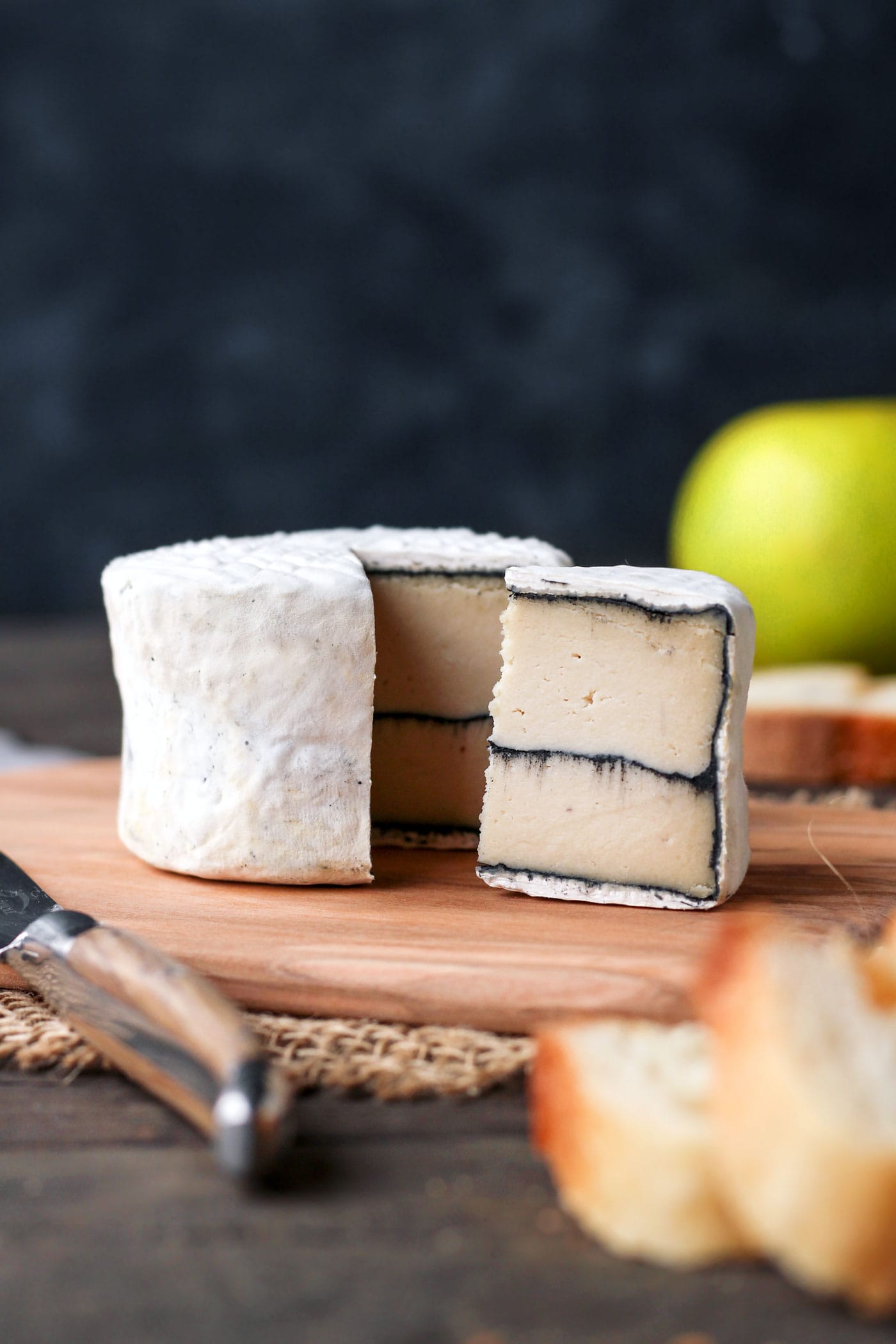
Back at it with another vegan cheese! Vegan Ash-Ripened Camembert!
As explained in the post last year, I was disappointed to see many people making my cheese recipes and not giving any credit, or even worse, claiming they created the recipe themselves. Some people went even further, trying to sell it through their business to customers. I can say that because they used the same “scramble” technique I created to have large blue veins inside the blue cheese.
Many of you sent me support emails at this time, and I really appreciate it. I figured you guys should not be deprived of new recipes just because of a few people. I realized there is no copyright on vegan cheese making; it doesn’t belong to anyone. Ultimately, the goal is to promote veganism, and the more experiments we share, the further we can go. That’s why I’m working on new cheese recipes I will publish here soon. There are three in the works, so stay tuned!
In the meantime, I thought I would share a recent experiment. This is more like an alternative version of my aged vegan camembert than a whole new recipe. However, I thought I would still share it because the taste is a bit different. And doesn’t it look cool? And it contains only 6 ingredients!
This camembert is first coated with vegetable ash and then naturally covered by a white mold (Penicillium camemberti). It also has a thin black line in the middle to make it look even cooler, a bit like Morbier cheese.
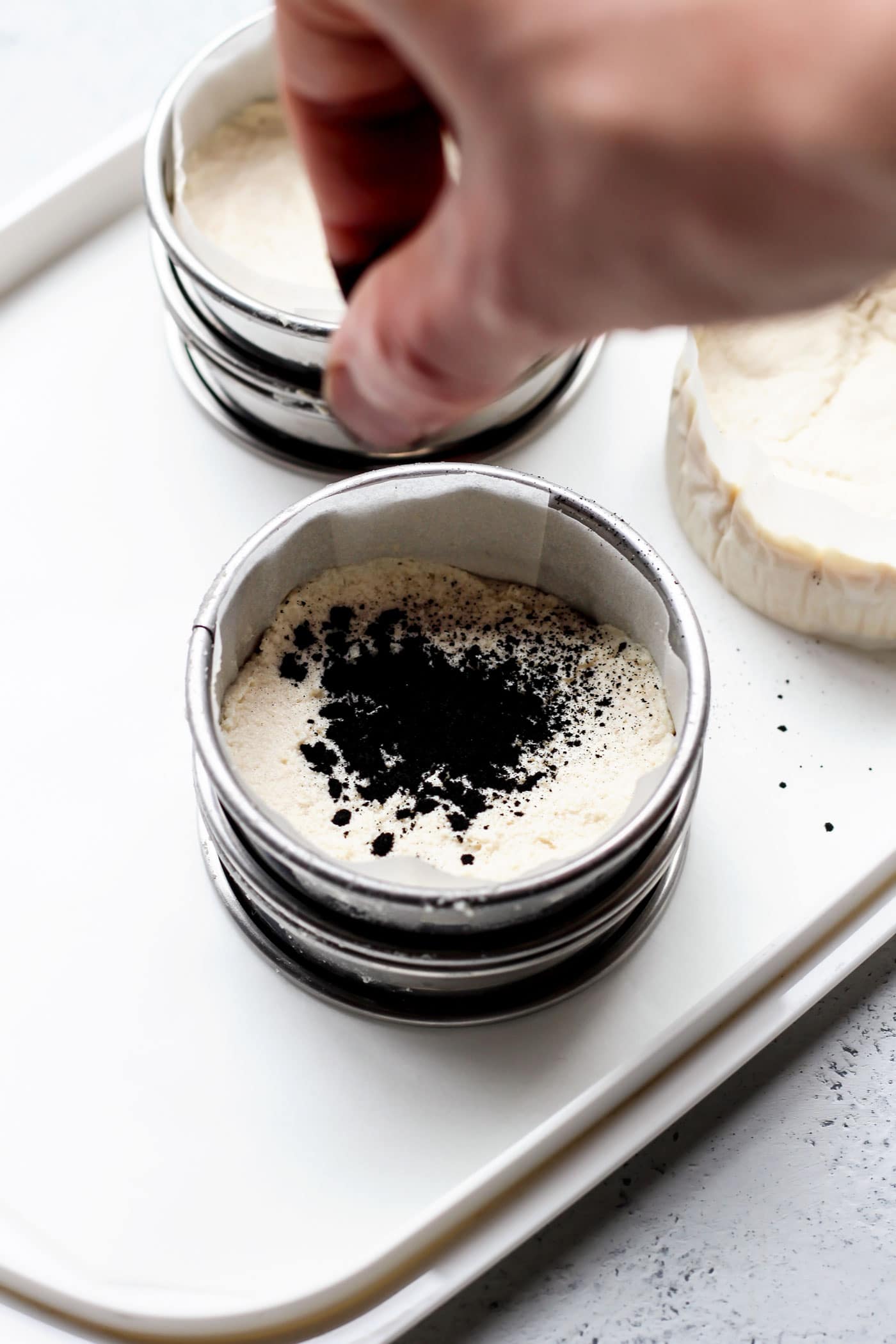
Vegetable ash (also called activated charcoal) is mostly used for aesthetics here, but it also helps lower the cheese’s acidity, giving it a milder flavor. The other advantage of using ash is that the white mold will grow quicker on the outside and prevent other bad molds from appearing.
I added some white miso to make the cheese a bit different taste-wise. It creates a more buttery flavor. Make sure to use a light one. Otherwise, it will be too salty.
Please check the links in the recipe regarding where to find the mold, cultures, and vegetable ash. If you are located in Europe, I recommend checking out cashewbert.com. They have everything you need to make all sorts of vegan cheeses, from cultures to supplies.

The technique is very similar to the one used in camembert cheese making, except you fill half of the molds with the cashew cream, sprinkle some vegetable ash, and cover with the rest of the cream. This creates a thin line in the center. For the exterior, you will use a mix of salt and ash. Salt will help the mold grow, penetrate the cheese, and add flavor.
After about 5-7 days, you should start to see some white mold growing on top of the ash. Now things are getting exciting! As you continue to flip it once a day, the mold will slowly cover the whole surface of the cheese and completely cover the black ash.
Once fully coated, you can wrap it in cheese paper and let it age for at least one additional week in the refrigerator. Complex flavors will develop, and the cheese will be then ready to eat.

The ash makes this cheese unique and will definitely surprise your guests once they cut through it and take a slice!
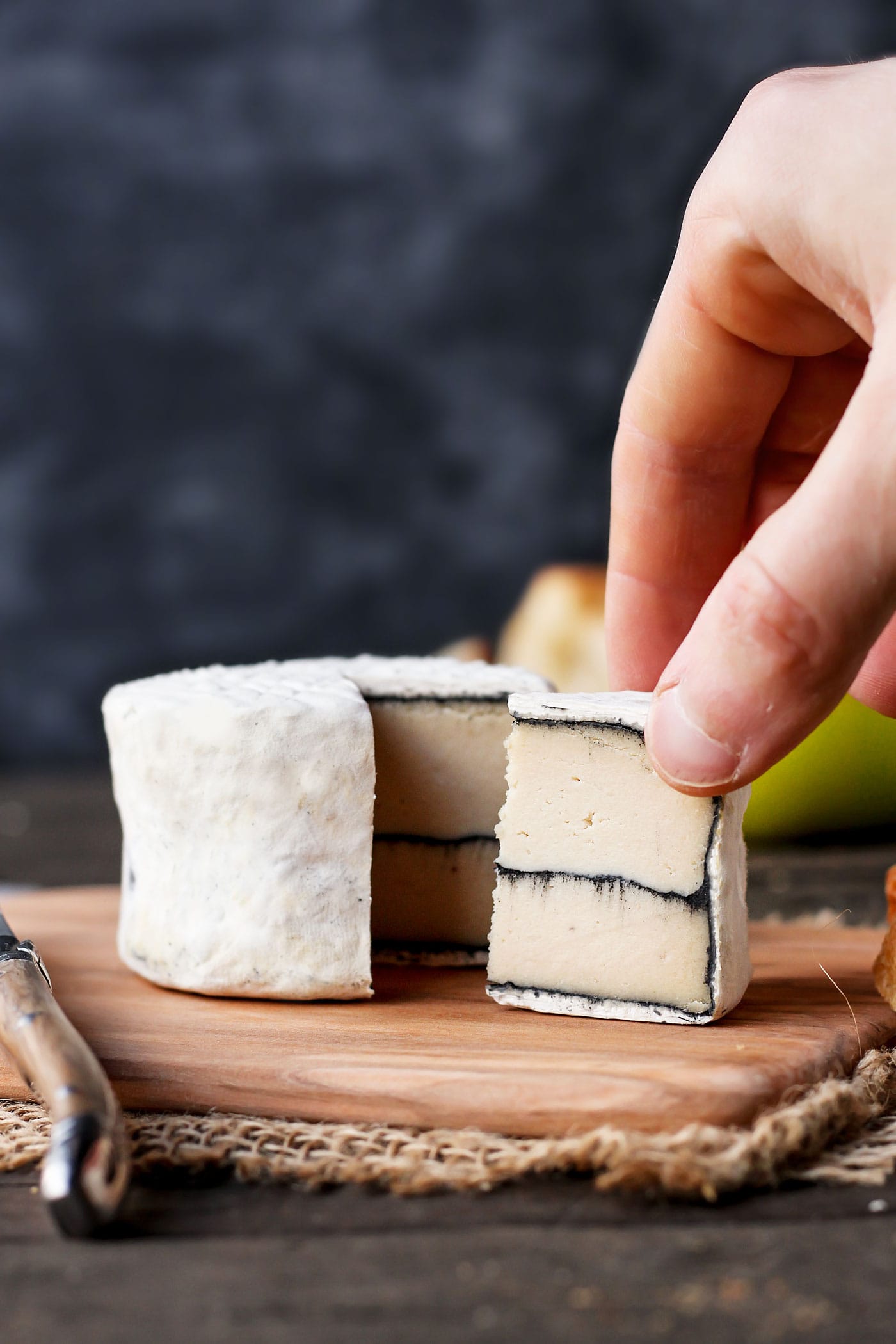
This vegan ash-ripened camembert would make a great addition to a vegan cheese platter with camembert, blue cheese, and hickory smoked vegan cheese!
If you have questions, please check out the comments on the vegan camembert post before. There is a lot of useful info, and questions answered.
As always, let me know in the comments if you try this recipe!
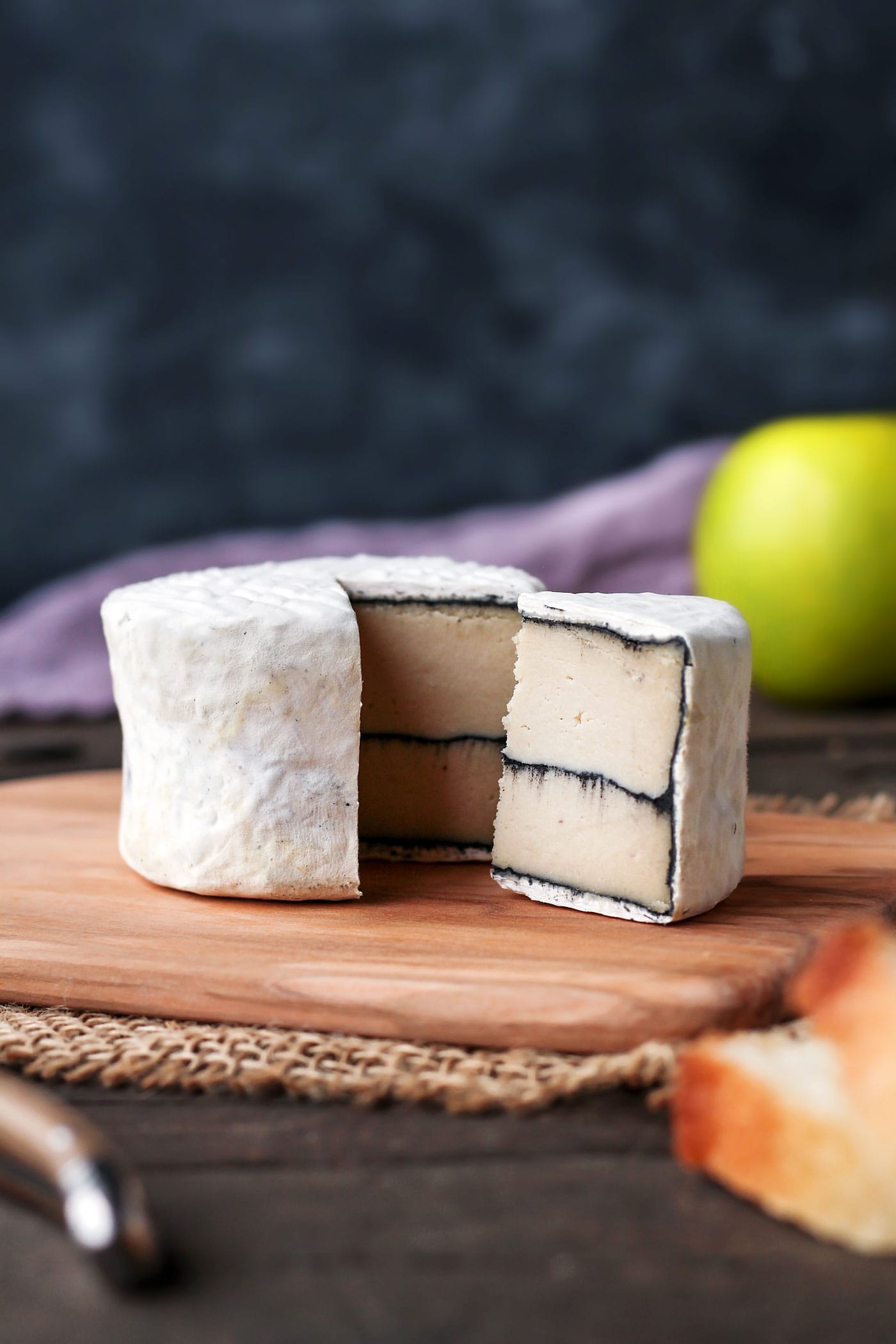

Want to Save This Recipe?
Enter your email below & we’ll send it straight to your inbox! Plus, you will receive new recipes every week!
I’d like to receive more tips & recipes from Full of Plants.
This site is protected by reCAPTCHA and the Google Privacy Policy and Terms of Service apply.

Vegan Ash-Ripened Camembert
Ingredients
- 3 cups raw cashews
- 2-3 tbsp filtered water or bottled water
- 1 tbsp light sweet miso
- 1/8 tsp mesophilic culture or 6 capsules acidophilus
- 1/16 tsp penicillium candidum
- 2 tbsp vegetable ash activated charcoal
- 2 tsp sea salt
Instructions
Cashews
- Soak the cashews in filtered water for at least 5 hours or overnight.
Making The Cheeses
- Drain the cashews and place them in a large bowl. Bring a large pot of water to a boil, transfer the boiling water to the cashew bowl, and let sit for 1-2 minutes. This step will help kill viable bacteria.
- Drain the cashews and place them in the bowl of the blender (or food processor) with the miso and 2 tbsp water.
- Blend on high speed, scraping down the sides from time to time, this step might take about 10 minutes depending on your blender. You want a very smooth yet thick texture. If needed, add 1 tablespoon of water at a time until smooth. Do not add too much water, you want to use as least as possible otherwise the cheese will be too soft.
- Open the probiotic capsules and add the powder to the bowl. You can use a mesophilic culture starter instead if you prefer. Both will work. Blend for a few seconds.
- Add the penicillium candidum and blend for another 10-15 seconds. If your penicillium candidum is in liquid form, use about one drop.
- Transfer the mixture to a cheesecloth and pull it tight. Add a weight above it and let it sit at room temperature for 10-12 hours. I placed the cheesecloth in a colander on top of a bowl. This step is important to start the fermentation of the cashew cream and drain possible excess water.
- After about 12 hours, the cashew cream should have a slightly sour taste, like fresh cream cheese. Transfer to a clean bowl, cover with plastic film to touch and place in the refrigerator for about 4 hours. It will make the cashew cream easier to work with.
- Cut strips of parchment paper and lay them in 3 small springform pans (I used two 3-inch cookie cutter rounds, stacked to make it taller). You want to cover the sides and bottom of the springform pans. You can also use plastic film if you prefer. The goal is to prevent the cheese from touching the metal. Fill half the pans with the mixture and press it down using plastic film so it doesn't stick to your hands. Make sure the surface is flat.
- Sprinkle a bit less than 1/4 tsp of ash on top of the cashew mixture and spread lightly with your finger. Don't add too much ash, you want a very thin line. Otherwise, the other half of the cashew cream won't stick to the bottom one.
- Finally, top the ash with more cashew cream, filling the pans to the top. Press it down firmly using a plastic film or latex gloves. Cover the pans with plastic film to touch and place in the refrigerator for 24-36 hours.
- After that, prepare the ash mixture: in a small bowl, mix 2 tbsp vegetable ash with 2 tsp sea salt. Carefully remove the cheeses from their springform pans and salt on both sides with about 1/4 tsp of the ash-salt mixture. Do the same for the sides. Shake each cheese a bit to remove excess ash.
- Line a clean baking sheet with parchment paper. Place each cheese on the baking sheet and cover with glass or plastic containers. This is essential to keep enough humidity and allow the mold to grow. Place the baking sheet in the refrigerator. I recommend setting the temperature of your fridge around 48-52°F.
Aging
- Every day for the next 4-5 days, carefully flip the cheeses. The cheeses will still be very soft, like cream cheese. Don't worry. They will be easier to work with after a few days. If droplets form inside the containers, drain them with a paper kitchen towel. If the parchment paper becomes too wet, change it.
- On day 5, move the cheeses to a bamboo mat or clean a thick grid. Keep them covered during the whole process.
- Continue to flip the cheeses daily for the next 7-10 days. Always use clean hands or work with a plastic film to be sure you are not touching the cheese. The mold will start to appear on day 8-10, depending on the humidity and temperature of your fridge. After another week or so, the cheeses should be fully covered with white mold.
- Once they are completely white, wrap the cheeses in parchment paper or cheese paper and place them in the refrigerator for at least 5 days. The longer you let them age in the refrigerator, the stronger the taste.
- Enjoy with French bread, nuts, and/or drizzle with maple syrup!
- The cheese will keep for at least 1 month in the refrigerator.
Notes
Nutrition
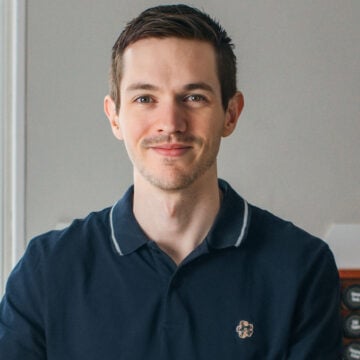
About the Author
Thomas Pagot is the founder, photographer, and recipe developer behind Full of Plants. He created the blog in 2016 as a personal cookbook for vegan recipes. Through years of recipe development, Thomas has successfully grown Full of Plants into a trusted resource for plant-based recipes.



Leave a Comment
Hi Thomas! I used to do with ash only outside, I like this idea to put inside too. Thank for sharing!
You are welcome Estella!
I made the Ashed Camembert and it was fantastically awesome! Thanks so much for the recipe ❤️. I’m now on batch 2. My vegan friends are amazed at the flavour, texture, creaminess and not simply an « imitation » !!!
Yay!! You are welcome Laura, I’m glad you are enjoying the recipes 🙂
Olá Thomas! estou muito feliz e grata por você existir e compartilhar seus conhecimentos!
Tenho testado muitas das suas receitas, sempre com resultados excelentes!
Estou com o queijo Camembert vegano em andamento, os primeiros sinais do molde começaram a surgir, estou realmente muito feliz e me divertindo bastante com tudo o que venho aprendendo, você é um espetáculo!
grande abraço
Thanks for your kind words, I’m glad you like the recipe!
Great recipe,thanks Thomas.
I have an issue with a mold growth.
It’s only a tiny speck on the cheese visible after a month.
Please advise what is possible troubleshooting for it.
Thanks in advance and good luck.
Ed
Hi Thomas, if I added a middle layer of dukkah and then covered the cheese in ash, would this adversely affect anything? Also, with the standard Camembert, can I add a few walnut pieces and maple syrup or lemon essential oil (edible) and dried dill or other flavours without it impacting the successful fermentation of the cheese? I am happy to try a few flavours out, but wondered if you had any advice? Thank you
Hi Kay,
Adding spices should not affect the aging of the cheese, so go for it! 🙂
Regarding the walnuts I’m not sure as these tend to turn rancid quickly. Essential oil, dried herbs, etc will not impact the process. Just add them after fermenting the cashew cream.
Thank you so much Thomas…one more question (sorry!)…can dried fruit such as sultanas be added or would the sugar content affect the cheese? Your recipes are brilliant!
I haven’t tried with dried fruits but I think it should work too.
Hi Thomas, thank you so much for these amazing recipes, you are so talented
I just wondered if I should use the full amount of the salt and ash mix or just the small amount on the sides, top and bottom? It seems to be too much to use all of it, but otherwise I am concerned I won’t be adding enough salt?
Also, regarding the blue cheese, when I made it the first time, it stopped growing mould after I scrambled it (at about the two week stage when it already had a lot of mould)….I am just trying it again and I am scrambling it after about 5 days when it has just started growing mould in the hope that this will help. Do you have any other suggestions?
Thank you again, Kay – Adelaide, South Australia (we have spent a significant amount of time house/pet-sitting and cycling in many parts of your beautiful country)
Hi Kay,
You should use just enough to cover the cheeses and then remove excess. I usually just sprinkle the ash/salt mixture over the top, bottom and sides of the cheeses.
If it stopped growing mold, it’s probably because the outside dried. Sometimes after scrambling you also have to be patient for the mold to grow again. If you can “scramble” after just 5 days and it already had mold then it should be okay.
Thanks 🙂
Thank you soooo much, that‘S exactly what happened, it was very dry!
Okay, fingers crossed for the new batch….we love these cheeses
Hello. I have probiotic capsules but they are glutamine 20 billion CFU per 2 capsules. Will this work? Thank you
Hi Shanell,
As explained many times in the comments, I cannot predict how a specific brand of a probiotic capsule will work. 20B sounds like a lot, I would use half of it.
I apologize for asking a question that you feel you had already previously answered. I read every single comment and didn’t see anything specifically regarding glutamine. I only hoped to get your educated opinion since I am new to this. I will refrain from asking questions in the future.
There are so many brands and types of probiotics it’s impossible to say if one will work except the one I tried and recommend. I once tried another brand of probiotics and my cashew cream turned bad (smelled like rotten eggs).
If you want to make sure it works I would recommend getting mesophilic culture specifically made for cheeses. Also, my ebook contain a lot of information regarding cultures, so feel free to check it out!
turned out it was just a peppercorn that i added to the cheese,
ive now had them ageing in the fridge covered for just about two weeks, the mould is growing but its actually like furry white mould, is this what it should look like? sorry im a bit scared of mould haha. thanks!
It should look like a uniform short white mold.
hey thomas, ive just finsihed the step of leaving it sit for 12 hours in a bowl, and it seemes to have some mould growing on top already, is this normal?
It’s not, scrape it off.
YOU ARE MY HERO
I want this right now with pickled red onions and good bread
Fantastic recipes Thomas! I have been having an issue with my white mold “rubbing off” once they are wrapped in parchment paper to age. It doesn’t happen all the time and I’m having trouble pinpointing what I am doing wrong. Any advice would be appreciated.
Hi Lynell,
It’s the first time I hear about this happening on vegan cheese. I know it can happen on dairy ones but I’m afraid I don’t know the exact reason.
Hello! I am planning to make this for part of my sister’s Christmas gift (she is lactose intolerant but loooves cheese so I want to do up a basket of goodies for her). Anyway I noticed this calls for miso but the original recipe doesn’t. Is there a reason for that? Could I add miso to the original recipe, or would that change it significantly?
Thanks so much for the amazing recipes!
Hello Miranda,
I added miso to create a cheese that has a slightly different flavor compared to my original camembert recipe. Miso adds a touch of sweetness and umami. Yes you can add miso to the original recipe!
Hi Thomas!
Just wondering what would be the result prolonged culturing, say 8 weeks? Would it dry out?
I am visiting my parents for christmas and cant take it with me due to customs, but I am visiting them about 8 weeks prior. Would that be okay?
Thankyou!
Hi Rae,
Yes, the cheese would become a lot drier if aged for a longer period of time. 8 weeks is a bit too long in my opinion.
Sensational recipes. So glad that you are sharing them with us all.
You’re welcome Boguslawa! Thanks 😉
Hi Thomas, first of all, you are a genius. I love your recipes!
I am very sorry that there are people taking advantage, but very happy that doesn’t stop you. People can only copy that much, you are the chef here 🙂
I would like to make this cheese and wondered if activated charcoal (which I have) is different than volcanic ash? I can order from cashewbert as I am in Europe, but if I have what I need than I prefer of course not, as it’s still an extra cost. In any case I will let you know the outcome!
Also, do you have any advice on how I could make a “blue” camembert? So using the 2 different molds, but only having a white rind. I have been thinking about this a bit now, but not really sure how to mix them.
Thank you so much for all you do. You brought my favourite cheeses back in my life.
Hi Diane,
Thanks for the kind words! There is a difference yes as one is “activated”, but for this particular recipe it won’t change anything, so feel free to use what you have one hand.
Regarding the blue camembert, I’m working on a recipe. I made several tests but still don’t have anything to share yet as I’m not fully happy with the results. It’s getting better though, so stay tuned!
Thank you so much! I will let you know how the cheese will work out 🙂
And yes blue camembert is my dream, so I will definitely stay tuned.
If publishing your recipes on the internet doesn’t constitute intellectual property (as it should) then putting your recipes together in a booklet does. Just collate them, put them in pdf with your name on it and it’s your intellectual property. Someone else can do this then may direct YOU to stop using ‘their’ recipes. To safeguard them, just document. You should be able to prove it’s your work due to publication date/data chain if challenged, but why not publish. Placing my order for your fabulous book now please! (PS, you can self publish, however if you put a pdf together, you can sell it again and again and again – no doubt a publisher will seek you out. No doubt – unless someone beats you to it.
An ebook is coming soon Kerri 😉
Thank you so much for these recipes; I can’t wait to try them out. As far as people/ companies stealing your recipes. I wonder if this is why Kite Hill stopped making their version?
You’re welcome! I don’t think so, I’m not sure why they stopped selling their camembert-style cheese.
Made the blue cheese and it was fantastic! I even froze some and am having it this evening— a month or so later — and it’s wonderful…
Hope you’re working on a feta!
Thanks.
Awesome! So happy to hear you liked this cheese recipe 🙂
For those allergic to nuts, is it recommended to use garbonzo beans or other white bean for the texture, etc?
I wouldn’t recommend it, garbanzo or white beans don’t have the same fat content. I have never tried, but the cheeses probably won’t be as creamy and I’m not sure how the mold and cultures would react.
I still think you’re a genius Thomas! You certainly can write a book of recipes – then they’re on the record and your intellectual property! You can sell your brand as opposed to profiting off your brilliant recipes. You’ll have ethical sponsors queueing up in no time. Love your work, thank you!
Thanks for the kind words Kerri! 🙂
Hi there just discovered your website, just wanted to suggest you make a cookbook with all your cheese recipes. Xx keep up the hard work xx michael
I made the Ash Ripened Camembert and the Vegan Blue at the same time, swapping almonds for cashews in both recipes and opting for acidophilus and omitting the miso since I hadn’t gotten my hands on a soy-free version at the time …I had to add a LOT more water with the almonds to get them moving in the Vitamix…I compensated by straining through cheesecloth-lined sieves before culturing. I had early indication that there was some bacterial contamination, so I wasn’t too disappointed at the end when I had to toss them, but I did go through the process just to see how the recipes behaved with the almonds…I am happy to say that they looked amazing and worked out well, just like the pictures…just not edible due to some pink bacteria growing on the cheese between the ‘skins’ and the cheese. Great learning project, thank you so much for the inspiration (your beautiful photos) and for sharing your recipe! I will be trying again soon, with some tweaks:)
Hi Amie,
Thank you so much for the feedback! Next time, make sure you pour boiling water on the cashews to kill possible bacterias and use super clean tools/equipment. It will reduce the possibilities of having bad bacterias growing.
so excited to try this version of the camembert! Have made all of your other cheese recipes and can say unequivocally that you are truly gifted! Thank you for your tenacity, and perseverance to perfect these amazing recipes!
Thanks Peg! I’m happy to hear you liked the other recipes 🙂
Hey Thomas! Love your recipes. I am currently making both your camembert and the blue cheese recipes. However, while set apart, I mixed up which is which! As I made two loaves of each cheese, I want to have a go at putting ash on my Camembert. Since I cant tell which is which, would it be okay if i ash one of the camembert and one of the blue? Would the ash/charcoal hinder the blue cheese’s growth? Should I just try next time?
Thank you so much for your innovation and your kind sharing with the vegan world!
Hey KK,
Haha 🙂 You should have used different size molds!
I guess you could do that, put ash on one cheese of each batch. I have no idea how it will work with blue cheese though. In my opinion, it won’t prevent the blue mold from growing as penicillium candidum grows above the ash, so you should be good.
Hi Thomas, I am wondering how you handle the skin that forms during the initial 12 hours in
the cheesecloth. I decided to ignore it and proceed as per your recipe. I hope it works out.
Thanks
Hi Bianca,
Good question. I usually remove it, but lately I have been covering the cashew cream with plastic film and I don’t have this problem anymore. I will update the recipe to make this step clearer.
Don’t worry if you left it, it won’t affect the aging process.
Hi Thomas, thanks for the reply. So, from what I understand we wrap them in cheesecloth to
let some of the moisture come out and make the cheese a bit firmer. Won’t covering it in plastic
wrap prevent the release of moisture?
Thanks again,
Bianca
Wrapping the cashew cream in a cheesecloth is useful if it is too liquid. If you only used a few tablespoons of water and the cream is already thick, you can simply transfer it to a clean bowl and cover with plastic film to touch. Again, I will update the recipe to make this step clearer.
Hello Thomas,
These cheeses look incredible. Congratulations.
I did have a question. I am not a big fan of the coconut flavor in my cheese.
I was wondering if another oil/fat could be used instead?
What is the reason for using coconut oil? Other then the richness and flavor?
Thanks and look forward to hearing back from you.
Hey Domenico,
Thanks! I assume you are talking about the blue cheese recipe. In the recipe, I recommend using refined coconut oil since it has no coconut flavor. Coconut oil helps in the ripening process, as the blue mold needs a bit more fat than penicillium candidum for example. It also makes the cheeses richer and helps to handle them at the beginning (coconut oil will firm them up a bit).
I’m making this now with wild hazelnuts and charred leeks for the ash. It’s so amazing. Can’t wait to dig into it. Thomas, it looks like you use a wire mesh rack for your cheeses, with paper underneath. At what point in your culturing process do you use these racks? It would seem to allow airflow under the cheeses as well as all around. I use parchement paper and sometimes notice that the moisture gathers on it, and can help encourage other mold.
Saw a photo of your cheeses on Facebook 🙂 They look great Melissa!
I transfer the cheeses to a rack as soon as they are a bit firmer, usually when the white mold starts to appear (after 7-10 days). You are right, it allows the mold to grow more uniformly and quickly than if it’s on a parchment paper. I still flip them every day though, or at least every two days, and they must be covered with a box or container. Regarding the racks, it’s just refrigerator racks that I cleaned very well.
Can’t wait to hear how it tastes with hazelnuts!
Hello Thomas.
It’s been 6 weeks now since I made the cheese. It’s covered completly with nice white mold, but very very soft inside. I cut one to check. I wrapped it with special papper for cheese…but not sure if it’s the right thing to do,, since, again, the cheese is soft to the point that when you cut it, it gets mushy.
Thank you for teaching us so much
Vita
Hi Vita,
My guess is that you used a bit too much water when blending the cashews, in my opinion it’s not a bad thing actually. If you let it age 1-2 additional weeks it will be stronger in flavor, a bit firmer but still creamy, win-win 🙂
Yes, when the camemberts are fully covered by white mold it’s always a good idea to wrap them, there is no advantage of leaving them in contact with the air anymore.
May I know how come the cheese can’t touch the metal springform? Thanks!
If you don’t use parchment paper the cashew cream will stick to the metal springform pans, cheeses won’t be very easy to remove from the pan.